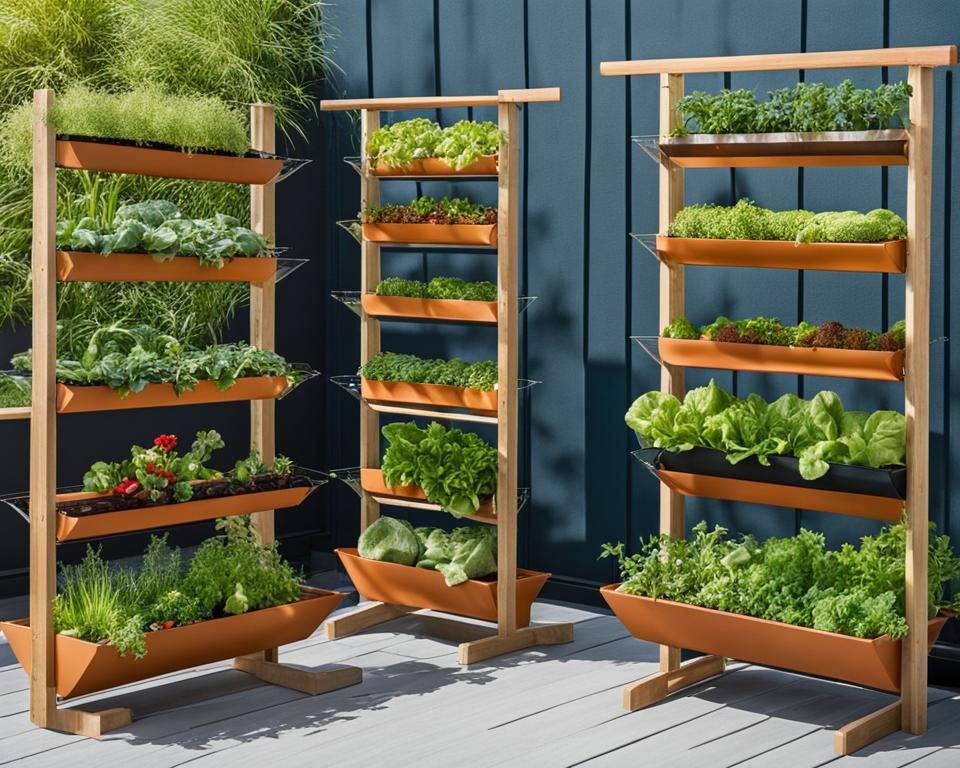Vertical gardening is a popular and efficient way to grow food, especially for those with limited space. In this article, I will provide a comprehensive guide to mastering DIY vertical vegetable gardening systems. You will learn about the benefits of vertical gardening, different types of vertical garden kits, and the best practices for creating your own vertical garden. Let’s get started!
- Vertical gardening is an excellent solution for those with limited space.
- It maximizes growing space and provides easy access to herbs and greens.
- Vertical gardens require less maintenance and have fewer weeds and pests.
- You can create vertical gardens using various materials and structures.
- Choosing the right vertical garden kit is crucial for success.
Why You Should Consider Vertical Gardening
Vertical gardening offers several advantages, making it an attractive option for gardeners of all levels. Firstly, it allows you to maximize your growing space, making it ideal for small gardens or urban areas where space is limited. Additionally, vertical gardens provide easy access to herbs and greens, reducing the need to travel to a separate garden plot. They also require less maintenance, as they have fewer weeds and pests compared to traditional gardens. Lastly, vertical gardens can serve as beautiful and functional decor, adding ambiance and privacy to your outdoor space.
One of the main benefits of vertical gardening is its ability to maximize space. By utilizing vertical surfaces such as walls or fences, you can grow plants upwards instead of outwards, allowing you to grow more in a smaller area. This is especially beneficial for those with limited garden space or urban dwellers with only a balcony or patio available. Vertical gardening also provides easy access to fresh herbs and greens, as they are within arm’s reach. This eliminates the need to travel to a separate garden plot or grocery store, saving time and money.
Vertical gardens also require less maintenance compared to traditional gardens. Since the plants are grown vertically, there are fewer weeds to contend with, as they have less space to grow. Vertical gardens also experience fewer pest problems, as many pests have difficulty accessing plants that are grown vertically. This reduces the need for pesticides and other chemical interventions, making vertical gardening a more eco-friendly option. Additionally, vertical gardens can serve as beautiful and functional decor, adding visual appeal and privacy to your outdoor space. Whether you choose to grow vines along a trellis or create a living wall of flowers, vertical gardens can enhance the aesthetic value of your home or garden.
| Benefits of Vertical Gardening |
|---|
| Maximizes growing space |
| Easy access to fresh herbs and greens |
| Requires less maintenance |
| Serves as beautiful and functional decor |
In conclusion, vertical gardening is a practical and aesthetically pleasing way to grow your own food, especially in small spaces or urban environments. The benefits of vertical gardening, such as maximizing space, easy access to fresh produce, reduced maintenance, and enhanced aesthetics, make it an attractive option for gardeners of all levels. Whether you choose to create a DIY vertical garden or invest in a vertical garden kit, the rewards of vertical gardening are sure to delight both your taste buds and your eyes.
What is a Vertical Garden?
A vertical garden is a unique and innovative gardening system that allows you to grow plants in a vertical fashion, making efficient use of space. Instead of traditional horizontal garden beds, plants are grown on a vertical surface using a framework such as pots or growing trays. This method is ideal for those with limited space or for adding greenery to walls, fences, or other vertical structures.
Vertical gardens can be created using a variety of materials, depending on your specific needs and available space. Some popular options include wire mesh, trellises, and even repurposed items like old gutters or pallets. The choice of materials and structure will depend on factors such as the weight of the plants, the desired aesthetic, and the ease of maintenance.
By utilizing a vertical garden, you can not only maximize your growing space but also create a visually appealing and sustainable garden. Whether you have a small balcony or a large backyard, vertical gardening allows you to unleash your creativity and transform any space into a green oasis.
Table: Pros and Cons of Different Vertical Garden Structures
| Structure | Pros | Cons |
|---|---|---|
| Wire Mesh | Easy to install and customize Provides good airflow and drainage |
May require additional support for heavier plants Can be less visually appealing compared to other structures |
| Trellises | Offers sturdy support for climbing plants Adds a decorative element to your garden |
May limit the variety of plants you can grow Requires regular maintenance to prevent overgrowth |
| Repurposed Items | Environmentally friendly option Allows for unique and creative designs |
May require additional preparation and modification Can deteriorate over time |
As you explore the world of vertical gardening, don’t be afraid to experiment with different structures and materials. Each garden is unique, and finding the right combination of elements will help you create a thriving vertical garden that brings beauty and nature into your surroundings.
Types of Vertical Garden Kits
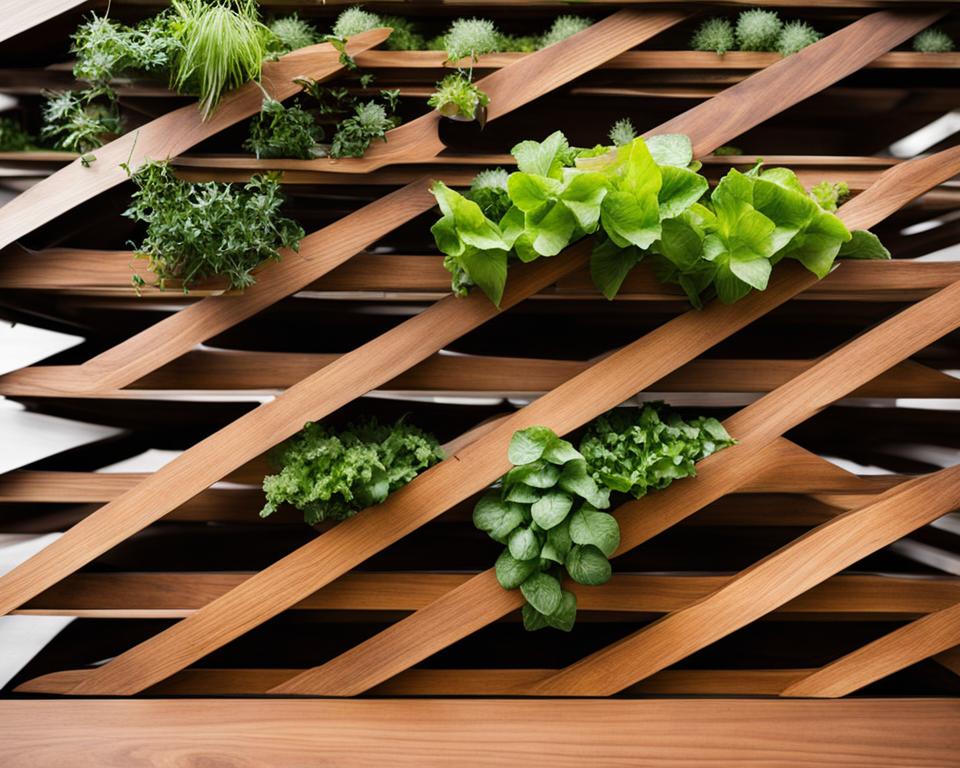
When it comes to vertical gardening, there are several types of garden kits available in the market. The choice of kit will depend on your specific needs and preferences. Let’s take a closer look at the different types of vertical garden kits:
Wall vs Circular Vertical Garden Kits
Wall vertical garden kits are versatile and can be easily attached to walls, fences, or posts. They provide a beautiful display of plants and offer easy access to sunlight. On the other hand, circular vertical garden kits are simple to set up and can be placed anywhere. They are a great option if you want flexibility in your garden’s placement.
Hydroponic vs Soil-Based Vertical Gardens
When it comes to the growing medium, you can choose between hydroponic or soil-based vertical garden kits. Hydroponic systems use water and nutrient solutions to grow plants, while soil-based systems use traditional soil. While hydroponic systems may seem appealing due to their efficient use of resources, soil-based systems are generally more reliable and provide better plant growth.
Pockets vs Containers
The containers used in vertical gardens can be either pocket design or container design. Pocket design containers are usually made of fabric or felt and have individual pockets for each plant. They are lightweight and allow for good drainage. Container design vertical garden kits, on the other hand, use individual pots or planters to hold the plants. They provide a more traditional gardening experience and allow for easy customization.
| Type of Vertical Garden Kit | Description |
|---|---|
| Wall Vertical Garden Kit | Versatile kits that can be attached to walls, fences, or posts. They provide a beautiful display of plants and easy access to sunlight. |
| Circular Vertical Garden Kit | Simple kits that can be placed anywhere. They are easy to set up and offer flexibility in garden placement. |
| Hydroponic Vertical Garden Kit | Uses water and nutrient solutions to grow plants. Provides efficient resource usage but may require more maintenance. |
| Soil-Based Vertical Garden Kit | Uses traditional soil for plant growth. Provides better plant growth and is generally more reliable. |
| Pocket Design Vertical Garden Kit | Uses fabric or felt containers with individual pockets for each plant. Lightweight and allows for good drainage. |
| Container Design Vertical Garden Kit | Uses individual pots or planters to hold the plants. Provides a more traditional gardening experience and allows for easy customization. |
The 6 Best Vertical Garden Kits
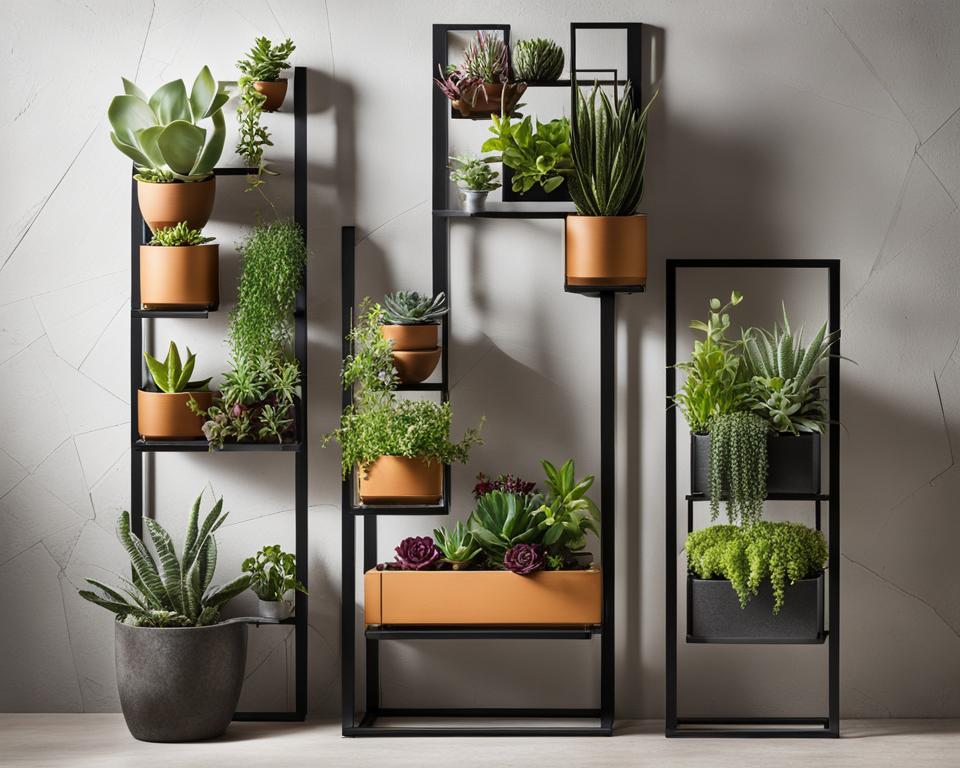
When it comes to vertical gardening, having the right kit can make all the difference. To help you get started, I’ve compiled a list of the 6 best vertical garden kits available on the market. These kits offer a variety of features and options to suit your specific needs and preferences.
Here are the top-rated vertical garden kits:
- Outdoor Varden™ Kit by Vertical Garden Supply: This kit is highly recommended for its innovative use of mesh socks filled with soil, providing ample room for plant roots to grow. It’s a versatile and efficient option for vertical gardening.
- Watex Green Living Vertical Garden Kit: This kit features a drip irrigation system that ensures efficient watering and reduces water waste. It’s perfect for those who want a low-maintenance vertical garden.
- Garden Tower: If you’re looking for a self-contained system that can grow up to 50 plants in a small space, the Garden Tower is an excellent choice. Its unique design allows for easy planting and harvesting.
- Hanging Pots: For a DIY option, hanging pots are a simple and affordable way to create a vertical garden. You can hang them on walls, fences, or even from a pergola to add a touch of greenery to your outdoor space.
- Gutter Systems: Repurposing old gutters is another creative DIY option for vertical gardening. Simply attach them to a wall or fence and fill them with soil to create a unique and space-saving vertical garden.
- Trellises: Trellises provide vertical support for climbing plants and can be incorporated into your existing garden or used as standalone structures for a vertical garden. They come in various sizes and styles to suit your aesthetic preferences.
When purchasing any of these vertical garden kits, be sure to check for any discounts or promotions available. This way, you can save money while creating a stunning and productive vertical garden.
Table: Comparison of the 6 Best Vertical Garden Kits
| Vertical Garden Kit | Features | Price | Customer Reviews |
|---|---|---|---|
| Outdoor Varden™ Kit by Vertical Garden Supply | Innovative mesh socks for optimal root growth | $99.99 | ★★★★★ |
| Watex Green Living Vertical Garden Kit | Drip irrigation system for efficient watering | $89.99 | ★★★★☆ |
| Garden Tower | Self-contained system with space for 50 plants | $199.99 | ★★★★★ |
| Hanging Pots | Simple and affordable DIY option | $19.99 (set of 3) | ★★★☆☆ |
| Gutter Systems | Repurposing old gutters for a unique vertical garden | $29.99 (10-foot length) | ★★★★☆ |
| Trellises | Vertical support for climbing plants | $39.99 | ★★★☆☆ |
Vertical Gardening Tips and Techniques
When it comes to vertical gardening, there are some key tips and techniques that can help you maximize your success. Whether you’re a novice gardener or have some experience, these tips will guide you towards creating a thriving vertical garden.
Choose the Right Plants
When selecting plants for your vertical garden, consider their growth habits and sunlight requirements. Choose plants that are well-suited for vertical growth, such as climbing veggies like cucumbers, beans, and tomatoes. Additionally, select plants that can thrive in the amount of sunlight your vertical garden receives, whether it’s full sun, partial shade, or full shade. By choosing the right plants, you’ll ensure that they have the best chance of thriving in your vertical garden.
Provide Adequate Support
Climbing plants in a vertical garden will need proper support to grow upward. Install trellises, mesh, or stakes to provide support for your plants as they grow. This will prevent them from becoming tangled or falling over. Be sure to regularly check and adjust the supports as your plants grow to ensure they have the necessary stability.
Spacing and Watering
Proper spacing is crucial in a vertical garden to avoid overcrowding and ensure optimal growth. Follow the planting instructions provided for each plant to determine the appropriate spacing between plants. Adequate spacing allows for proper air circulation and reduces the risk of diseases. Additionally, water your vertical garden regularly, taking into consideration the specific water needs of each plant. Provide enough water to keep the soil moist but not waterlogged, as overwatering can lead to root rot and other issues.
By following these tips and techniques, you’ll be well on your way to creating a successful vertical garden. Remember to choose the right plants, provide proper support, and ensure adequate spacing and watering. With a little care and attention, you’ll be rewarded with a thriving vertical garden that brings fresh produce and beauty to your space.
Vertical Gardening Ideas for Small Spaces
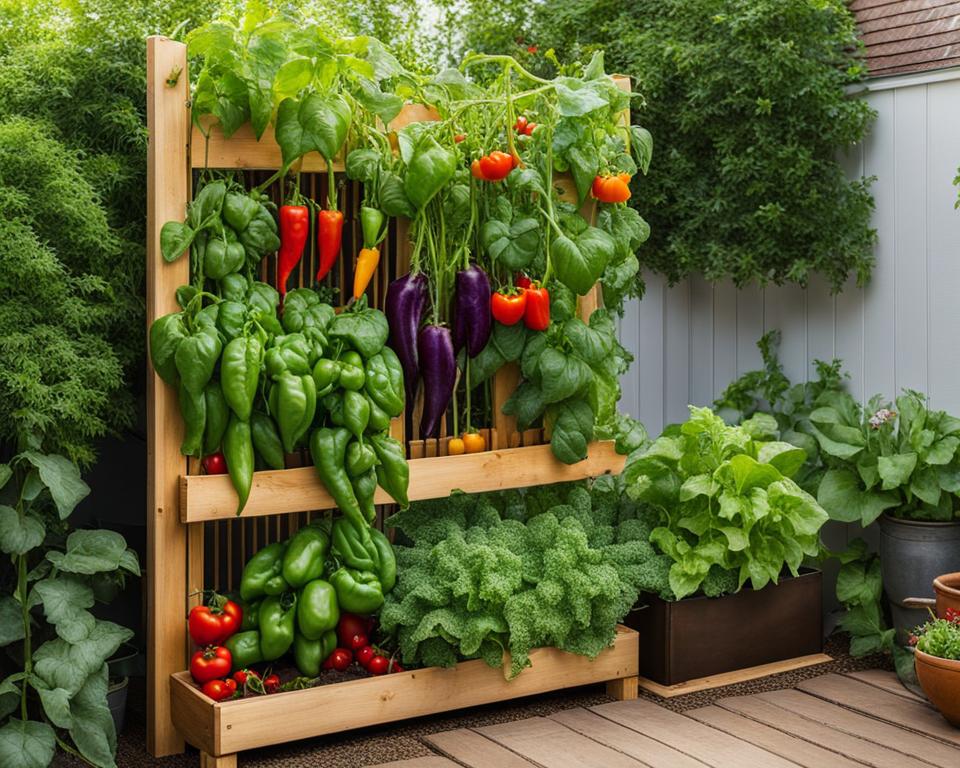
If you have limited space, don’t worry! Vertical gardening is the perfect solution for small spaces like apartments and balconies. Here are some creative ideas to help you maximize your vertical gardening potential:
1. Hanging Pots
Hang pots from hooks or a vertical structure, such as a trellis or railing. This allows you to grow a variety of herbs, flowers, and small vegetables without taking up valuable floor space. Choose lightweight pots and ensure proper drainage to prevent water damage.
2. Wall of Herbs or Greens
Create a stunning vertical garden by mounting planter boxes or pockets on a wall and filling them with herbs or leafy greens. This not only adds beauty to your space but also provides easy access to fresh ingredients for cooking.
3. Pocket Garden System
Utilize a pocket garden system to grow plants vertically. These systems consist of fabric pockets that can be hung on walls or fences. Fill each pocket with soil and plant your desired herbs, flowers, or vegetables. This method is particularly useful when space is limited, as the pockets can be hung at various heights.
By implementing these vertical gardening ideas, you can transform even the smallest of spaces into a thriving garden. Remember to choose plants that are suitable for vertical growth and provide proper care and maintenance to ensure their success.
| Idea | Description |
|---|---|
| Hanging Pots | Hang pots from hooks or a vertical structure, such as a trellis or railing. This allows you to grow a variety of herbs, flowers, and small vegetables without taking up valuable floor space. Choose lightweight pots and ensure proper drainage to prevent water damage. |
| Wall of Herbs or Greens | Create a stunning vertical garden by mounting planter boxes or pockets on a wall and filling them with herbs or leafy greens. This not only adds beauty to your space but also provides easy access to fresh ingredients for cooking. |
| Pocket Garden System | Utilize a pocket garden system to grow plants vertically. These systems consist of fabric pockets that can be hung on walls or fences. Fill each pocket with soil and plant your desired herbs, flowers, or vegetables. This method is particularly useful when space is limited, as the pockets can be hung at various heights. |
Vertical Gardening for Increased Yield
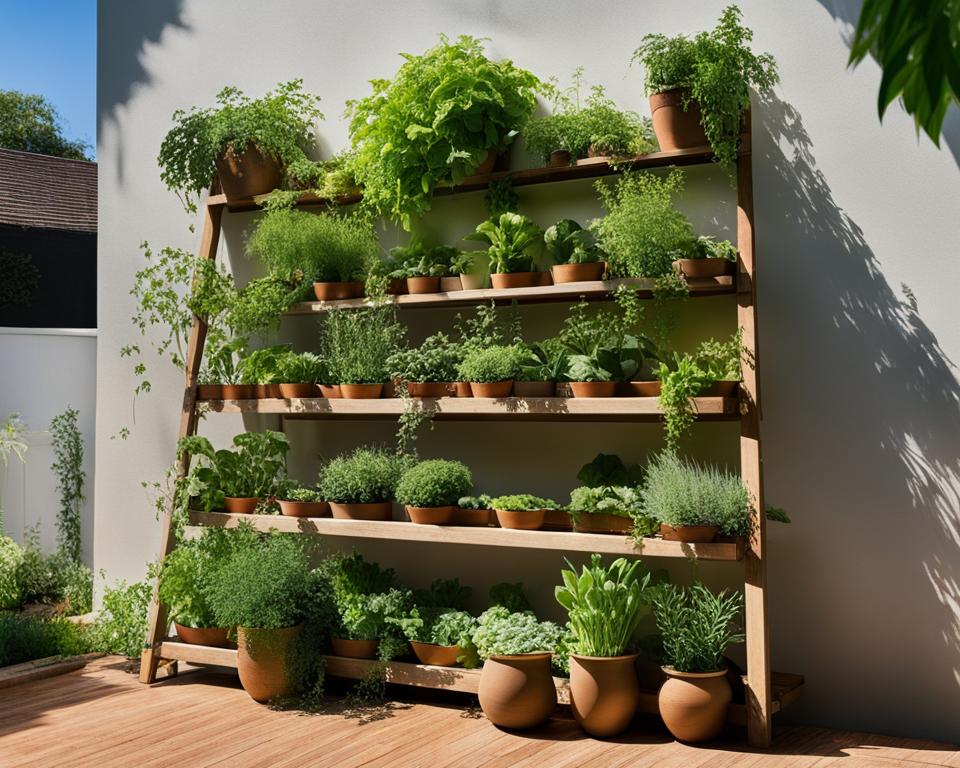
One of the major benefits of vertical gardening is the potential for increased yield. By utilizing vertical space, gardeners can grow more plants in a smaller area, resulting in a higher crop output and an abundance of fresh vegetables.
Vertical gardening systems allow for efficient use of sunlight and proper airflow, which are essential for healthy plant growth. With plants growing vertically, they can access sunlight from multiple angles, maximizing the photosynthesis process. Adequate airflow helps prevent the buildup of excess humidity, reducing the risk of fungal diseases and promoting overall plant health.
Furthermore, vertical gardening reduces competition for resources among plants. By providing each plant with its dedicated growing space, there is less competition for nutrients and water. This allows plants to absorb the necessary elements more efficiently, leading to better nutrient absorption, improved growth, and increased productivity.
Incorporating various vertical gardening techniques can further optimize yield. Pruning is crucial to remove excess foliage and redirect the plant’s energy towards fruit production. By removing unnecessary stems and leaves, the plant can channel its resources into developing larger and more abundant fruits.
Training is another technique that involves guiding plants’ growth along the vertical structure. This ensures that the plants receive optimal sunlight exposure and prevents them from sprawling or climbing uncontrollably. Supporting the plants with trellises or mesh can help keep them upright and encourages better airflow.
Proper spacing is also essential in vertical gardening to prevent overcrowding and competition for resources. By providing adequate space between plants, each one can receive the necessary nutrients, water, and sunlight without being hindered by neighboring plants. This promotes healthier growth and allows for easier maintenance and harvest.
| Vertical Gardening Techniques | Benefits |
|---|---|
| Pruning | Redirects plant energy towards fruit production |
| Training | Optimizes sunlight exposure and prevents sprawling |
| Proper Spacing | Prevents overcrowding and competition for resources |
Conclusion
After exploring the world of vertical gardening, it is evident that DIY vertical vegetable gardening systems offer a multitude of benefits. These systems allow you to maximize your growing space, making them perfect for small gardens and urban areas with limited space. Not only are they efficient, but they also provide easy access to fresh herbs and greens right at your fingertips.
By utilizing vertical gardening techniques and following the tips provided in this article, you can create your very own vertical vegetable garden. Whether you choose to use a vertical garden kit or get creative with repurposed materials, vertical gardening is an eco-friendly and rewarding way to enhance your gardening game.
Final Thoughts on Vertical Gardening
Vertical gardening offers a unique and innovative approach to growing your own food. It allows you to tap into unused vertical space, resulting in increased yield and a bountiful harvest. With vertical gardening, you can enjoy fresh and nutritious vegetables while beautifying your outdoor space.
So, don’t wait any longer. Take the leap and start mastering DIY vertical vegetable gardening systems today. Get your hands dirty, embrace your green thumb, and experience the joys of vertical gardening firsthand.
FAQ
What are the benefits of vertical gardening?
Vertical gardening allows you to maximize your growing space, provides easy access to herbs and greens, requires less maintenance, and adds beauty to your outdoor space.
What is a vertical garden?
A vertical garden is a gardening system that utilizes a framework, such as pots or growing trays, to grow plants in a vertical fashion, making efficient use of space.
What types of vertical garden kits are available?
There are wall kits, circular kits, hydroponic systems, soil-based systems, pocket design containers, and container design containers.
What are the best vertical garden kits?
Some top-rated options include the Outdoor Varden™ Kit by Vertical Garden Supply, the Watex Green Living Vertical Garden Kit, and the Garden Tower.
What tips and techniques should I follow for successful vertical vegetable gardening?
Choose appropriate plants, provide adequate support, ensure proper spacing, water regularly, add organic matter to the soil, and monitor for pests and diseases.
How can I do vertical gardening in small spaces?
Use hanging pots, create a wall of herbs or greens, utilize a pocket garden system, or consider trellises or portable vertical garden kits.
How does vertical gardening increase yield?
Vertical gardening allows for more plants in a smaller area, efficient use of sunlight and airflow, and reduces competition for resources among plants.

